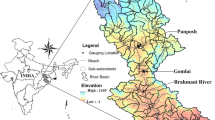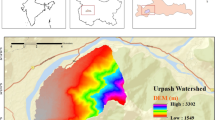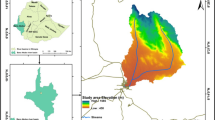Abstract
The effects of soil erosion are most horrible in developing countries, where agriculturalists are very unable to recover soil fertility using purchased inputs. Evidence on soil loss is vital for encouraging farming productivity and natural resource management. Simulation models are the most active way to predict soil loss processes and their result by using geographic information system and remote sensing. Soil erosion modeling used mathematical equations that require many data measurements as well as physical description of the erosion phenomena. The main goal of this research was to delineate areas that require prior soil conservation measures and to predict the amount of soil loss at the Abbay-Awash basin. The soil loss was assessed by using the Revised Universal Soil Equation (RUSLE) model. The layers were then overlaid and multiplied pixel by pixel, using the RUSLE model and raster calculator-reprocessing tool in Arc GIS 10.1 environment. Annual soil losses range from 0 in the lowlands of the watershed to more than 500 tons ha−1 year−1 in much of the steeper slopes on tributaries. Based on the analysis, the amount of soil loss in the Abbay basin from Wollo area is about 3.52 million tons per year from 1.765 million hectares and also in the Awash basin from the Wollo area about 0.58 million tons per year from 0.787 million hectares area. A detailed examination showed that the most pronounced RUSLE factor that worsened soil erosion and caused a high soil loss rate was the slope length (L), steepness (S) factors, and low vegetation cover. Thus, planners should adapt their soil and water conservation measure implementation strategies by devoting in the very urgent part of the watershed first and then progressively to the needed part to prevent the influence of runoff at its start point.










Similar content being viewed by others
Data Availability
All data generated and analyzed during this study are included in this published article.
References
El Garouani A, El Aroussi O, Jabrane A, Jabrane K, El Jadida BP (2017) Soil erosion evaluation and mapping based on geomatic techniques in Wadi El Malleh Watershed Asmaa Nasser Mohamed EID , PhD student. https://doi.org/10.19044/esj.2017.v13n18p211
Sewnet H, Amare (2016) International soil and water conservation research soil loss estimation using GIS and remote sensing techniques : a case of Koga watershed, Northwestern Ethiopia. Int Soil Water Conserv Res 4(2):126–136. https://doi.org/10.1016/j.iswcr.2016.01.002
Betrie GD, Yasir A (2007) Sediment management modelling in the Blue Nile Basin using SWAT model. pp 5497–5527
Roose (1975) Soil erosion hazard under the current and potential climate change induced chapter 7 soil erosion hazard under the current and potential climate change induced loss of soil organic matter in the Upper Blue Nile (Abay) River basin, Ethiopia, no. December 2017. https://doi.org/10.1007/978-3-319-09360-4.
Catchments S, Gholami FR, Mousavi M (n.d.) Mesoscale mapping of sediment source hotspots for dam sediment management in data-sparse. no. April, 2016
FAO (1984) Journal of Sustainable Development in Africa (Volume 13, No.3, 2011), 13(3):87–106
Haregeweyn N et al (2017) Science of the total environment comprehensive assessment of soil erosion risk for better land use planning in river basins : case study of the Upper Blue Nile River. Sci Total Environ 574:95–108. https://doi.org/10.1016/j.scitotenv.2016.09.019
Abdel-aziz TM (2017) Water and sediment management. no. March 2009
U. N. Educational (2009) Report on soil erosion processes in the Nile Basin. no. May
Hailu AH, Kibret K, Gebrekidan H (2015) Characterization and classification of soils of Kabe Subwatershed in South Wollo Zone , Northeastern Ethiopia
Yesuph AY, Dagnew AB (2019) Soil erosion mapping and severity analysis based on RUSLE model and local perception in the Beshillo Catchment of the Blue Nile Basin. Environ Syst Res 1–21. https://doi.org/10.1186/s40068-019-0145-1.
Tekle K, Hedlund L (2000) Land cover changes between 1958 and 1986 district, Kalu Wello, Southern 20(1): 42–51
Abebe T, Gebremariam B (2019) Modeling runoff and sediment yield of Kesem dam watershed, Awash basin, Ethiopia. SN Appl Sci 1(5):1–13. https://doi.org/10.1007/s42452-019-0347-1
Ethiopian N, Tana NL (2011) Soil erosion mapping and hotspot area identification using GIS and remote soil erosion mapping and hotspot area identification using GIS and remote sensing in northwest Ethiopian highlands , near, no. January. https://doi.org/10.1007/978-94-007-0689-7
Morgan RPC (1974) Soil erosion and conservation. Silsoe College, Cranf. Univ
Morgan RPC (1994) Estimating regional variation in soil erosion hazard in Peninsular, Malaysia. Malayan Nat J 28:94–106
Smith DD, Wischmeier WH (1978) Predicting rainfall erosion loss. USDA, Agric. Res. Serv. Handb. 537
Lane JL, Foster GR (1981) Simulation of erosion and sediment yield from field-sized areas. In: Lal R, Russell EW (eds) Trop. Agric. Hydrol. . Chichester, Wiley, pp 375–394
G. I. S. Case and G. Watershed (2012) Mapping soil erosion and sediment yield susceptibility using RUSLE, remote. no. January
Hurni H (1985) Land degradation, famine and resource scenarios in Ethiopia. In: Pimentel D (ed) World soil erosion and conservation. Cambridge Univ. Press, Cambridge
Acknowledgements
The research was implemented under a collaborative partnership between the Awash-Abbay basin director at Wollo University, so the authors would like to thank to these organizations for the financial and other support during this work. We also acknowledge the anonymous reviewers, whose comments greatly improved the paper.
Author information
Authors and Affiliations
Contributions
Tewodros Desale conceived and developed the research framework. Tewodros Desalew, Girum Metaferia, and Metafet Asmare undertook the data processing and analysis. Shawol Abebe, Girum Metaferia, and Eshetu Shifaw wrote and revised the manuscript. Eshetu Shifaw and Wondye Molla supervised and revised the manuscript. All authors have read and agreed to the published version of the manuscript.
Corresponding author
Ethics declarations
Conflict of Interest
The author declares no competing interests.
Additional information
Publisher's Note
Springer Nature remains neutral with regard to jurisdictional claims in published maps and institutional affiliations.
Rights and permissions
Springer Nature or its licensor (e.g. a society or other partner) holds exclusive rights to this article under a publishing agreement with the author(s) or other rightsholder(s); author self-archiving of the accepted manuscript version of this article is solely governed by the terms of such publishing agreement and applicable law.
About this article
Cite this article
Desale, T., Metaferia, G., Shifaw, E. et al. Identification and Prioritization of Sub-watersheds to Soil Erosion and Sediment Yield Susceptibility Using RUSLE, Remote Sensing, and GIS (Case Study: Abbay—Awash Basin in Wollo Area, Ethiopia). Water Conserv Sci Eng 8, 1 (2023). https://doi.org/10.1007/s41101-023-00179-y
Received:
Revised:
Accepted:
Published:
DOI: https://doi.org/10.1007/s41101-023-00179-y




